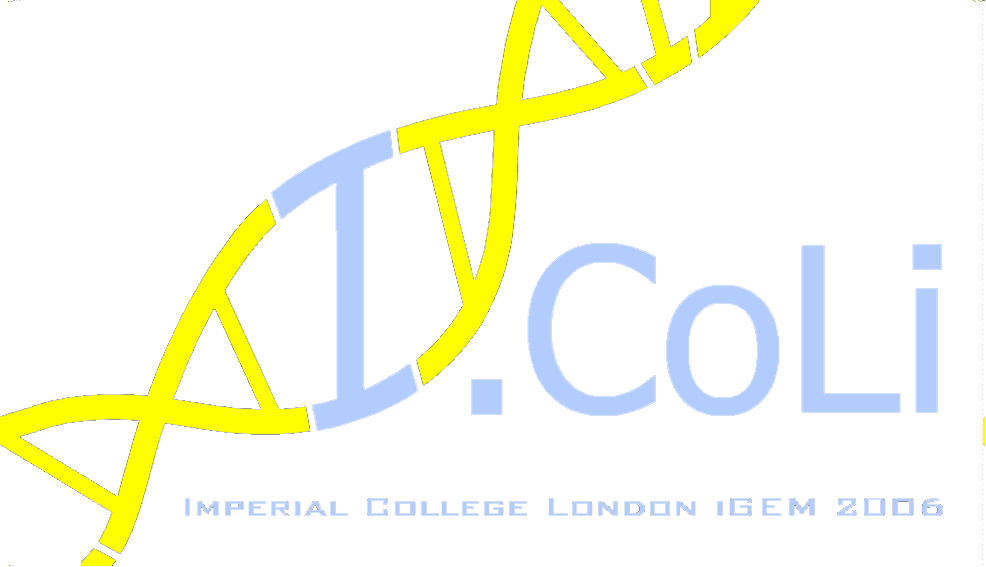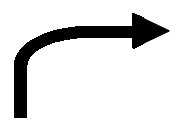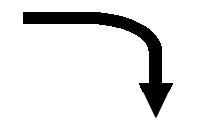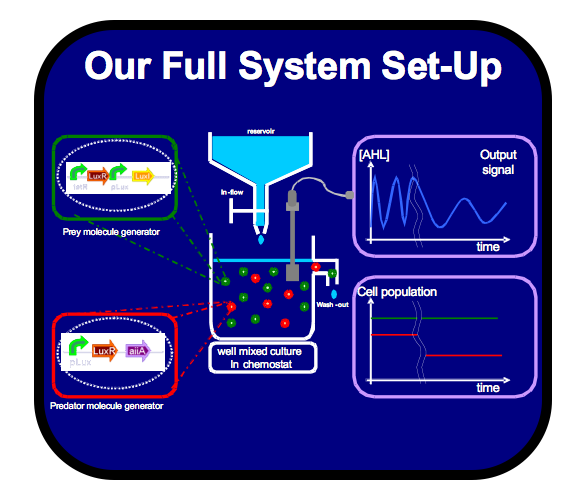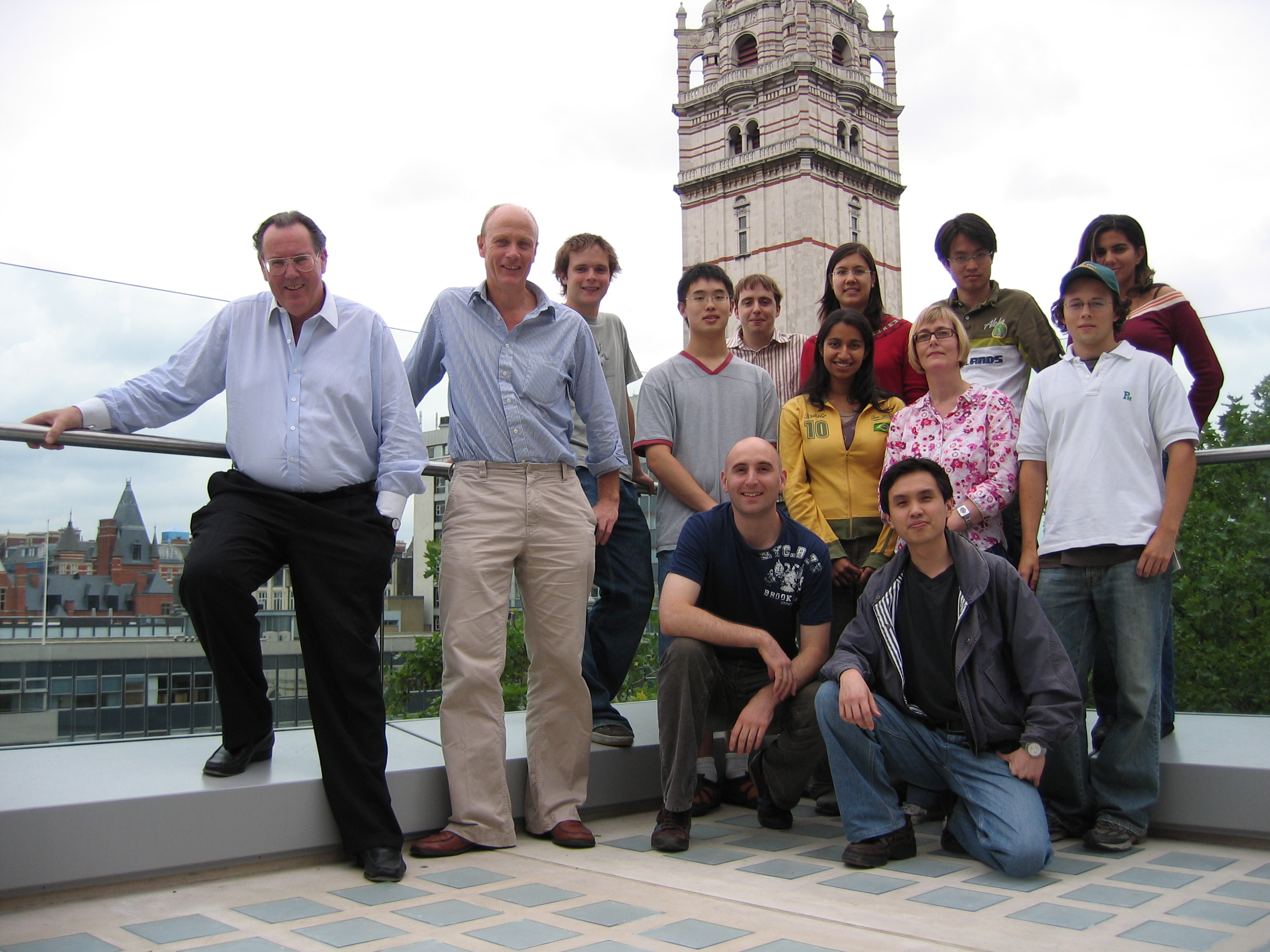Imperial College 2006
From 2006.igem.org
(Difference between revisions)
(→Differential Equations Derived) |
(→Main Project) |
||
| (22 intermediate revisions not shown) | |||
| Line 1: | Line 1: | ||
__NOTOC__ | __NOTOC__ | ||
| - | [[Image: | + | __NOTOC__ |
| + | <center>[[Image:Banner.png|800px]]</center> | ||
| - | |||
| - | + | <center><font size="4">'''[http://openwetware.org/wiki/IGEM:IMPERIAL/2006 Full Documentation of the project on OpenWetWare]'''</font></center> | |
| + | <center><font size="3">'''[[Media:IGEM_Imperial_2006_presentation.pdf |Presentation ]]'''</font></center> | ||
| + | <center><font size="3">'''[[Media:IGEM_Imperial_2006_Poster.pdf |Poster]]'''</font></center> | ||
| - | |||
| - | |||
| - | [[Image: | + | {| border="0" width="100%" style="padding: 5px; background-color: #ffffff; border: 2px solid #2171B8;" |
| + | |- | ||
| + | |width="20%" style="background:#2171B8"|[[Image:LogoFinal2.png|210px|center]] | ||
| + | |width="40%" style="background:#2171B8"| <font face="arial" font style="color: #FFFFFF" > | ||
| + | <center><big><u>'''Project Summary'''</u></big></center> | ||
| - | |||
| - | === | + | *We have used the traditional engineering approach to build a stable and flexible molecular oscillator |
| + | *Our original design relies on population dynamics and was inspired by the Lotka-Volterra predation model | ||
| + | *Every step of the development cycle (Specifications, Design, Modelling, Implementation, Testing/Validation) has been fully documented on our OWW site</font> | ||
| + | |width="40%" style="background:#2171B8" | <font face="arial" font style="color: #FFFFFF" > | ||
| - | |||
| - | |||
| - | |||
| - | |||
| - | + | <center><big><u>'''Achievements'''</u></big></center> | |
| + | <br> | ||
| + | *Derivation of the complete dynamical model, describing the main biochemical reactions driving our oscillator | ||
| + | *Full theoretical analysis and detailed computer simulations, validating our design with regard to our specifications | ||
| + | *Successful building and characterization of functional parts, providing the building blocks for the final oscillator | ||
| + | <br> | ||
| + | <br> | ||
| + | <br> | ||
| + | </font> | ||
| + | |} | ||
| - | |||
| - | |||
| - | |||
| - | |||
| - | |||
| - | |||
| - | |||
| - | |||
| - | + | ==Main Project== | |
| - | + | {| border="0" width="100%" align="center" style="padding: 5px; background-color: #ffffff; border: 2px solid #2171B8;" | |
| - | ** | + | | width="20%" style="background:#2171B8"| <center>[[Image:Oscillator Icon.PNG|100px|center]] </center> |
| - | * | + | | style="background:#2171B8" colspan="3"| <font face="arial" font style="color: yellow"> <center><big>'''Engineering a Molecular Predation Oscillator'''</big><br> |
| - | * | + | <font face="arial" font style="color: #ffffff">For building our biological oscillator, the engineering cycle below was followed.<br> |
| - | ** | + | '''<font style="color: orange">Click</font> on <font style="color: orange">each</font> of the stages of the <font style="color: orange">engineering cycle</font> below in order to find out about the different stages & aspects of the project. '''</font></center> |
| - | ** | + | |- |
| - | * | + | | style="background:#2171B8" width="200pt" rowspan="4" | |
| + | [http://openwetware.org/wiki/IGEM:IMPERIAL/2006/project/Oscillator/project_browser/Full_System <font face="arial" font style="color: yellow"> '''1) Specifications: '''</font>] | ||
| + | <font face="arial" font style="color: #ffffff"> | ||
| + | *Stable and robust oscillations | ||
| + | *Controllable frequency/amplitude | ||
| + | *Generic and modular</font> | ||
| + | [http://openwetware.org/wiki/IGEM:IMPERIAL/2006/project/Oscillator/project_browser/Full_System/Design <font face="arial" font style="color: yellow">'''2) Design: '''</font>] | ||
| + | <font face="arial" font style="color: #ffffff"> | ||
| + | *Mimics predator-prey dynamics based on the Lotka-Volterra model | ||
| + | </font> | ||
| + | [http://openwetware.org/wiki/IGEM:IMPERIAL/2006/project/Oscillator/project_browser/Full_System/Modelling <font face="arial" font style="color: yellow">'''3) Modelling: '''</font>] | ||
| + | <font face="arial" font style="color: #ffffff"> | ||
| + | *[http://www.openwetware.org/wiki/IGEM:IMPERIAL/2006/project/Oscillator/Theoretical_Analyses <font face="arial" font style="color: #FFFFFF">Full theoretical analysis</font>] | ||
| + | *Modelling of the full system | ||
| + | </font> | ||
| + | [http://openwetware.org/wiki/IGEM:IMPERIAL/2006/project/Oscillator/project_browser/Full_System/Implementation <font face="arial" font style="color: yellow"> '''4) Implementation: '''</font>] | ||
| + | <font face="arial" font style="color: #ffffff"> | ||
| + | *All parts designed and modelled | ||
| + | *4 functional & 5 intermediate submitted to the Registry | ||
| + | </font> | ||
| + | [http://www.openwetware.org/wiki/IGEM:IMPERIAL/2006/project/Oscillator/project_browser/Full_System/TestingValidation <font face="arial" font style="color: yellow">'''5) Testing/ Validation: '''</font>] | ||
| + | <font face="arial" font style="color: #ffffff"> | ||
| + | *Successful characterization of sub-components. | ||
| + | </font> | ||
| + | | align="right"|[[Image:ArrowCurvedRight.png|110px]] | ||
| + | | align="center" |[http://www.openwetware.org/wiki/IGEM:IMPERIAL/2006/project/Oscillator/project_browser/Full_System http://openwetware.org/images/f/fd/IGEM_IMPERIAL_DevCycle_Specifications.png]<font style="color:red"><br>Click on picture for more info</font> | ||
| + | | align="left"|[[Image:ArrowCurvedDown.PNG|120px]] | ||
| + | |- | ||
| + | | align="center"|[http://www.openwetware.org/wiki/IGEM:IMPERIAL/2006/project/Oscillator/project_browser/Full_System/TestingValidation http://openwetware.org/images/2/20/IGEM_IMPERIAL_DevCycle_Validation.png]<font style="color:red"><br>Click on picture for more info</font> | ||
| + | | align="center" rowspan="2"|[[Image:IGEM_IMPERIAL_DevCycle_FullSystem.png |206px|center]] | ||
| + | | align="center"|[http://www.openwetware.org/wiki/IGEM:IMPERIAL/2006/project/Oscillator/project_browser/Full_System/Design http://openwetware.org/images/c/ce/IGEM_IMPERIAL_DevCycle_Design.png]<font style="color:red"><br>Click on picture for more info</font> | ||
| + | |- | ||
| + | | align="center"|[[Image:ArrowUp.png|20px]] | ||
| + | | align="center"|[[Image:ArrowDown.png|20px]] | ||
| + | |- | ||
| + | | align="center"|[http://www.openwetware.org/wiki/IGEM:IMPERIAL/2006/project/Oscillator/project_browser/Full_System/Implementation http://openwetware.org/images/0/04/IGEM_IMPERIAL_DevCycle_Implementation.png]<font style="color:red"><br>Click on picture for more info</font> | ||
| + | | align="center"|[[Image:ArrowLeft.png|150px]] | ||
| + | | align="center"|[http://www.openwetware.org/wiki/IGEM:IMPERIAL/2006/project/Oscillator/project_browser/Full_System/Modelling http://openwetware.org/images/5/5f/IGEM_IMPERIAL_DevCycle_Modelling.png]<font style="color:red"><br>Click on picture for more info</font> | ||
| + | |} | ||
| - | [[ | + | ==Secondary Projects== |
| + | {| border="0" width="100%" style="padding: 5px; background-color: #ffffff; border: 2px solid #2171B8;" width="100%" | ||
| + | |- | ||
| + | ! width="50%" | <big>'''[http://openwetware.org/wiki/IGEM:IMPERIAL/2006/project/popsblocker <font face="arial" font style="color: #2171B8">PoPs Blocker</font>] '''</big>!! width="50%"| <big>'''[http://openwetware.org/wiki/IGEM:IMPERIAL/2006/project/Bio_elec_interface <font face="arial" font style="color: #2171B8">Biological to Electrical Interface]</font>'''</big> | ||
| + | |- | ||
| + | | style="background:#2171B8" width="50%" | | ||
| + | <font face="arial" font style="color: #FFFFFF"> As a method of controlling the activation of the positive-feedback loop in our predator-prey based oscillator, we successfully created this part, which can be used as a general Pops Blocker: | ||
| + | *This part is placed downstream of a promoter and prevents any Pops from the promoter passing through this part | ||
| + | *When an accompanying Cre Recombinase plasmid becomes activated, the enzyme produced will permanently cut a section of DNA from the plasmid containing this part | ||
| + | *Only then, the polymerase can pass through this part and transcribe downstream genes. | ||
| + | </font> | ||
| + | | style="background:#2171B8" width="50%" | | ||
| + | <font face="arial" font style="color: #FFFFFF">We also worked on a Biosensor for measuring AHL concentrations in order to establish a Biological to Electrical Interface this summer. | ||
| + | *Using an enzyme to hydrolize the lactone AHL would result in a local change in pH | ||
| + | *Measuring the change in pH gives a measurement of how much AHL is present. | ||
| + | <br> | ||
| + | <br> | ||
| + | <br> | ||
| + | <br> | ||
| + | </font> | ||
| + | |} | ||
| - | ===Test Constructs=== | + | ==Our Contributions to the Registry== |
| + | {|border="0" width="100%" style="padding: 5px; background-color: #ffffff; border: 2px solid #2171B8;" | ||
| + | ! style="background:#2171B8" | <font face="arial" font style="color: #FFFFFF">Part Logo !! style="background:#2171B8" |<font face="arial" font style="color: #FFFFFF">Description</font> !! style="background:#2171B8" |<font face="arial" font style="color: #FFFFFF">Link to registry</font> !! style="background:#2171B8" |<font face="arial" font style="color: #FFFFFF">Built</font> !! style="background:#2171B8" |<font face="arial" font style="color: #FFFFFF">Tested </font>!! style="background:#2171B8" |<font face="arial" font style="color: #FFFFFF">Characterized </font>!! style="background:#2171B8" |<font face="arial" font style="color: #FFFFFF">Sequenced</font> !! style="background:#2171B8" |<font face="arial" font style="color: #FFFFFF">Sent</font> | ||
| + | |- | ||
| + | !style="background:#008080" |<font face="arial" font style="color: #FFFFFF">Final Constructs</font> | ||
| + | !style="background:#008080"|<font face="arial" font style="color: orange">(!) Favorite Part</font> | ||
| + | !style="background:#008080"| | ||
| + | !style="background:#008080"| | ||
| + | !style="background:#008080"| | ||
| + | !style="background:#008080"| | ||
| + | !style="background:#008080"| | ||
| + | !style="background:#008080"| | ||
| + | |- | ||
| + | ![[Image:J37015.PNG|250px]]!! Final Prey Cell <font face="arial" font style="color: orange">(!) </font> !! <bbpart>J37015</bbpart> !! YES !! YES !! Pending !! YES !! YES | ||
| + | |- | ||
| + | ! [[Image:J37027.png|120px]] !! Cre/Lox Prey Control <font face="arial" font style="color: orange">(!) </font>!! <bbpart>J37027</bbpart> !! YES !! YES !! YES !! YES !!YES | ||
| + | |- | ||
| + | !style="background:#008080" |<font face="arial" font style="color: #FFFFFF">Test Constructs</font> | ||
| + | !style="background:#008080"| | ||
| + | !style="background:#008080"| | ||
| + | !style="background:#008080"| | ||
| + | !style="background:#008080"| | ||
| + | !style="background:#008080"| | ||
| + | !style="background:#008080"| | ||
| + | !style="background:#008080"| | ||
| + | |- | ||
| + | ![[Image:J37016.PNG|150px]]!! Final Polycistronic Predator Cell Test Construct <font face="arial" font style="color: orange">(!) </font>!! <bbpart>J37016</bbpart> !! YES !! YES !! YES !! YES!! YES | ||
| + | |- | ||
| + | ! [[Image:J37020.png|170px]] !! Predator Cell, pLux Transfer Function (two promoters) !! <bbpart>J37020</bbpart> !! YES !! YES !! NO !! NO !! YES | ||
| + | |- | ||
| + | !style="background:#008080" |<font face="arial" font style="color: #FFFFFF">Intermediate Parts</font> | ||
| + | !style="background:#008080"| | ||
| + | !style="background:#008080"| | ||
| + | !style="background:#008080"| | ||
| + | !style="background:#008080"| | ||
| + | !style="background:#008080"| | ||
| + | !style="background:#008080"| | ||
| + | !style="background:#008080"| | ||
| + | |- | ||
| + | ! [[Image:J37019.PNG|80px]] !! AHL induced LuxR generator (for predator cell) !! <bbpart>J37019</bbpart> !! YES !! N/A !! N/A!! YES !!YES | ||
| + | |- | ||
| + | ! [[Image:J37033.PNG|65px]] !! RBS + LuxR !! <bbpart>J37033</bbpart> !! YES !! N/A !! N/A!! YES !!YES | ||
| + | |- | ||
| + | ! [[Image:J37034.PNG|90px]] !! Prey Cell Intermediate!! <bbpart>J37034</bbpart> !! YES !! N/A !! N/A!! YES !!YES | ||
| + | |- | ||
| + | ! [[Image:J37032.png|90px]] !! LuxR + GFP !! <bbpart>J37032</bbpart> !! YES !! N/A !! N/A!! YES !!YES | ||
| + | |} | ||
| - | + | ==Our Open Documentation== | |
| - | + | ||
| - | + | ||
| - | + | ||
| - | + | ||
| - | + | *'''<font face="arial" font style="color: #2171B8">300+ Pages of documentation on OWW, 100's of Photographs, Extensive Modelling, Lab Notebook and much more!</font>''' | |
| + | __NOTOC__ | ||
| + | {| class="wikitable" border="0" cellpadding="10" cellspacing="1" style="padding: 5px; background-color: #ffffff; border: 2px solid #2171B8;text-align:center" | ||
| + | !width="20%" align="left" valign="top" style="background:#2171B8; color:black"| | ||
| - | *< | + | *[http://openwetware.org/wiki/IGEM:IMPERIAL/2006 <font face="arial" font style="color: #FFFFFF">iGEM@imperial</font>] |
| - | * | + | *[http://openwetware.org/wiki/IGEM:IMPERIAL/2006/project/Oscillator/project_browser <font face="arial" font style="color: #FFFFFF">Oscillator project</font>] |
| - | * | + | *[http://openwetware.org/wiki/IGEM:IMPERIAL/2006/project/popsblocker <font face="arial" font style="color: #FFFFFF">PoPs Blocker project</font>] |
| - | * | + | *[http://openwetware.org/wiki/IGEM:IMPERIAL/2006/project/Bio_elec_interface <font face="arial" font style="color: #FFFFFF">AHL Biosensor project</font>] |
| - | + | ||
| - | + | ||
| - | |||
| - | *< | + | !width="20%" align="left" valign="top" style="background:#2171B8; color:black"| |
| - | * | + | *[http://openwetware.org/wiki/IGEM:IMPERIAL/2006/LabCalendar <font face="arial" font style="color: #FFFFFF">Lab Notebook</font>] |
| - | * | + | *[http://openwetware.org/wiki/IGEM:IMPERIAL/2006/Protocols <font face="arial" font style="color: #FFFFFF">Protocols</font>] |
| - | * | + | *[http://openwetware.org/wiki/IGEM:IMPERIAL/2006/Journal_Club<font face="arial" font style="color: #FFFFFF"> Journal Club</font>]<br\> |
| + | *[http://openwetware.org/wiki/IGEM:IMPERIAL/2006/Lecture_Notes <font face="arial" font style="color: #FFFFFF">Lecture Notes</font>]<br\> | ||
| - | [[ | + | !width="20%" align="left" valign="top" style="background:#2171B8; color:black"| |
| + | *[http://openwetware.org/wiki/BioSysBio:abstracts/2007/iGEM2006_Imperial_College <font face="arial" font style="color: #FFFFFF">BioSysBio Conference, UK</font>] | ||
| + | *[http://openwetware.org/wiki/IGEM:IMPERIAL/Methodology <font face="arial" font style="color: #FFFFFF">Description of our Methodology</font>] | ||
| + | !width="20%" align="left" valign="top" style="background:#2171B8; color:black"| | ||
| + | *[http://openwetware.org/wiki/IGEM:IMPERIAL/2006/Calendar/2006-7-26 <font face="arial" font style="color: #FFFFFF">UK iGEM Teams Meeting</font>] | ||
| + | *[http://openwetware.org/wiki/IGEM:IMPERIAL/2006/Photos <font face="arial" font style="color: #FFFFFF">Photos</font>] | ||
| + | *[http://openwetware.org/wiki/IGEM:IMPERIAL/2006/Instructors_Feedbacks <font face="arial" font style="color: #FFFFFF">Feedbacks on our experience</font>] | ||
| + | |} | ||
| - | == | + | ==The Team and Acknowledgements== |
| - | + | {| class="wikitable" border="0" width="100%" cellpadding="10" cellspacing="1" style="padding: 5px; background-color: #ffffff; border: 2px solid #2171B8;text-align:center" | |
| + | !width="20%" align="left" valign="top" style="background:#2171B8; color:black"| | ||
| + | <center> | ||
| - | == | + | ==<font face="arial" font style="color: #FFFFFF">Undergrads</font>== |
| + | </center> | ||
| + | *[http://openwetware.org/wiki/User:Cys <font face="arial" font style="color: #FFFFFF">Christin Sander</font>] | ||
| + | *[http://openwetware.org/wiki/User:da104 <font face="arial" font style="color: #FFFFFF">Deepti Aswani</font>] | ||
| + | *[http://openwetware.org/wiki/User:Farah <font face="arial" font style="color: #FFFFFF">Farah Vohra</font>] | ||
| + | *[http://openwetware.org/wiki/User:Baijiongjun<font face="arial" font style="color: #FFFFFF"> Jiongjun Bai</font>] | ||
| + | *[http://openwetware.org/wiki/User:Johnsy <font face="arial" font style="color: #FFFFFF">John Sy</font>] | ||
| + | *[http://openwetware.org/wiki/User:JohnChattaway <font face="arial" font style="color: #FFFFFF">John Chattaway</font>] | ||
| + | *[http://openwetware.org/wiki/User:Jonny<font face="arial" font style="color: #FFFFFF"> Jonathan Wells</font>] | ||
| + | *[http://openwetware.org/wiki/User:Tom <font face="arial" font style="color: #FFFFFF">Tom Hinson</font>] | ||
| - | + | !width="25%" align="left" valign="top" color:black"| | |
| - | + | [[Image:IGEM GroupPhotos0015.JPG|thumb|center|200px|The Imperial College iGEM team and advisors on the terrace of the Biochemistry building]] | |
| - | + | !width="20%" align="left" valign="top" style="background:#2171B8; color:black"| | |
| + | <center> | ||
| - | == | + | ==<font face="arial" font style="color: #FFFFFF">Advisors</font>== |
| + | </center> | ||
| + | *[http://www3.imperial.ac.uk/people/r.kitney <font face="arial" font style="color: #FFFFFF">Prof. Richard Kitney</font>] | ||
| + | *[http://www3.imperial.ac.uk/people/p.freemont <font face="arial" font style="color: #FFFFFF">Prof. Paul Freemont</font>] | ||
| + | *[http://www3.imperial.ac.uk/people/d.mann <font face="arial" font style="color: #FFFFFF">Dr. David Mann</font>] | ||
| + | *<font face="arial" font style="color: #FFFFFF">Kirsten Jensen</font> | ||
| + | *[http://openwetware.org/wiki/User:Vincent <font face="arial" font style="color: #FFFFFF">Vincent Rouilly</font>] | ||
| + | *[http://openwetware.org/wiki/User:chuehloo <font face="arial" font style="color: #FFFFFF">Chueh-Loo Poh</font>] | ||
| + | *[http://openwetware.org/wiki/User:SxE00 <font face="arial" font style="color: #FFFFFF">Matthieu Bultelle</font>] | ||
| - | === | + | !width="20%" align="left" valign="top" style="background:#2171B8; color:white"| |
| - | + | ||
| - | + | ||
| - | + | ||
| - | + | <center> | |
| - | + | ||
| - | + | ||
| - | + | ||
| - | + | ||
| - | + | ||
| - | === | + | ==<font face="arial" font style="color: #FFFFFF">Funding</font>== |
| - | + | </center> | |
| - | < | + | *European Commission |
| - | + | *Imperial College Deputy Rector's Fund | |
| - | + | *Imperial College Faculty of Engineering | |
| - | + | *Imperial College Faculty of Natural Sciences | |
| + | |} | ||
| - | == | + | <html> |
| + | <!-- Start of StatCounter Code --> | ||
| + | <script type="text/javascript" language="javascript"> | ||
| + | var sc_project=1999432; | ||
| + | var sc_invisible=1; | ||
| + | var sc_partition=18; | ||
| + | var sc_security="3a523ad5"; | ||
| + | </script> | ||
| - | + | <script type="text/javascript" language="javascript" src="http://www.statcounter.com/counter/frames.js"></script><noscript><a href="http://www.statcounter.com/" target="_blank"><img src="http://c19.statcounter.com/counter.php?sc_project=1999432&java=0&security=3a523ad5&invisible=1" alt="hit counter script" border="0"></a> </noscript> | |
| - | + | <!-- End of StatCounter Code --> | |
| - | == | + | </html> |
| - | + | ||
| - | + | ||
| - | + | ||
| - | + | ||
| - | + | ||
| - | + | ||
| - | + | ||
| - | + | ||
| - | + | ||
| - | + | ||
| - | + | ||
| - | + | ||
| - | + | ||
| - | + | ||
| - | + | ||
| - | + | ||
| - | + | ||
| - | + | ||
| - | + | ||
| - | + | ||
| - | + | ||
| - | + | ||
| - | + | ||
| - | + | ||
| - | + | ||
| - | + | ||
| - | + | ||
| - | + | ||
| - | + | ||
| - | + | ||
| - | + | ||
| - | + | ||
| - | + | ||
| - | + | ||
| - | + | ||
| - | + | ||
| - | + | ||
| - | + | ||
| - | + | ||
| - | + | ||
| - | + | ||
Latest revision as of 16:42, 10 November 2006

|
|
|
Main Project
Secondary Projects
| [http://openwetware.org/wiki/IGEM:IMPERIAL/2006/project/popsblocker PoPs Blocker] | [http://openwetware.org/wiki/IGEM:IMPERIAL/2006/project/Bio_elec_interface Biological to Electrical Interface] |
|---|---|
|
As a method of controlling the activation of the positive-feedback loop in our predator-prey based oscillator, we successfully created this part, which can be used as a general Pops Blocker:
|
We also worked on a Biosensor for measuring AHL concentrations in order to establish a Biological to Electrical Interface this summer.
|
Our Contributions to the Registry
| Part Logo | Description | Link to registry | Built | Tested | Characterized | Sequenced | Sent |
|---|---|---|---|---|---|---|---|
| Final Constructs | (!) Favorite Part | ||||||
| Final Prey Cell (!) | J37015 | YES | YES | Pending | YES | YES | |
| | Cre/Lox Prey Control (!) | J37027 | YES | YES | YES | YES | YES |
| Test Constructs | |||||||
| Final Polycistronic Predator Cell Test Construct (!) | J37016 | YES | YES | YES | YES | YES | |
| | Predator Cell, pLux Transfer Function (two promoters) | J37020 | YES | YES | NO | NO | YES |
| Intermediate Parts | |||||||
| | AHL induced LuxR generator (for predator cell) | J37019 | YES | N/A | N/A | YES | YES |
| | RBS + LuxR | J37033 | YES | N/A | N/A | YES | YES |
| | Prey Cell Intermediate | J37034 | YES | N/A | N/A | YES | YES |
| | LuxR + GFP | J37032 | YES | N/A | N/A | YES | YES |
Our Open Documentation
- 300+ Pages of documentation on OWW, 100's of Photographs, Extensive Modelling, Lab Notebook and much more!
|
|
|
|
|---|
The Team and Acknowledgements
Undergrads
|
Advisors
|
Funding
|
|---|
